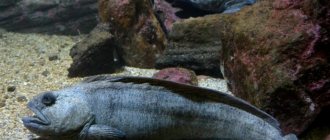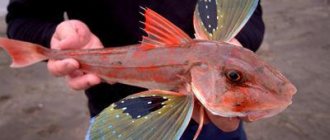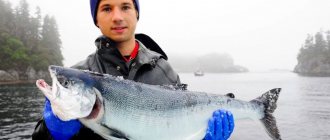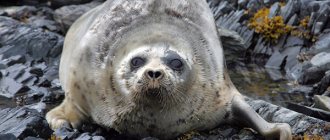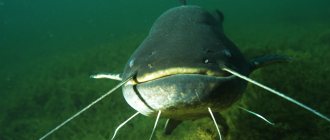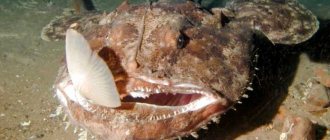Alexander Agafonov, Anton Chernetsky “Nature” No. 5, 2019
Sea hare (sealed seal). Photos of the authors
About the authors
| Alexander Vladislavovich Agafonov — Candidate of Biological Sciences, researcher at the laboratory of marine mammals at the P. P. Shirshov Institute of Oceanology of the Russian Academy of Sciences and the Karadag Scientific Station named after T. I. Vyazemsky, a natural reserve of the Russian Academy of Sciences. Area of scientific interests: the origin and development of sign systems, the acoustic communication system of dolphins. |
| Anton Dmitrievich Chernetsky - Researcher at the Laboratory of Marine Mammals at the P. P. Shirshov Institute of Oceanology of the Russian Academy of Sciences. Area of scientific interests is the study of the behavior, distribution and social structure of marine mammal communities. |
It is known that underwater acoustic signaling plays a significant role in the life of dolphins (and cetaceans in general): this includes orientation in conditions where vision can help little (echolocation), and the organization of normal life activities of communities (communication), and a system of group and individual “call signs” . But in addition to whales and dolphins, other mammals also live in the water, for example, pinnipeds - walruses, seals, fur seals, etc. Data from paleontological and genetic studies show that their ancestors were terrestrial predatory animals, closest to the genera of martens ( Martes
) or bears (
Ursus
), and recently taxonomists have generally tended to combine carnivores and pinnipeds into one order. Although pinnipeds spend quite a lot of time on land (or on ice), in the sea they feel just like fish in water. How are things going with underwater acoustic signaling? Studies have shown that animals of this group are more likely to reproduce (produce) sounds in the air. However, underwater acoustic activity has also been discovered in some species. And in this regard, one of the most interesting objects was the sea hare.
Who are sea hares?
Sea hare or bearded seal ( Erignatus barbatus
), is one of the largest representatives of the subfamily of true seals: the body length of animals of this species can reach 2.5 m and weight - 300 kg.
History is silent about where such a strange name came from in the Russian language - the seal bears no resemblance to an ordinary hare. In English it is called a bearded seal
, which can at least be explained by the presence of thicker whiskers than other seals, which, being an organ of touch, may help it in obtaining food. Sea hares are benthophages, i.e. They feed mainly on all bottom living creatures (mollusks, worms, arthropods), but they can also profit from fish.
Sea hares are widespread in all Arctic seas, as well as in the Bering and Okhotsk seas. They are characterized by a sedentary, solitary lifestyle. Information about the areas where these seals stay during the period when the sea is completely or partially covered with ice is very contradictory. Most authors consider them to inhabit only drifting ice [], although there is information about the presence of E. barbatus
in the zone of stable fast ice [2–4]. Meanwhile, the end of winter and the beginning of spring is a very important time in the life of the species: from March to May, sealed cubs are born (the timing varies within the range), then the females feed them with milk (for a short time - up to 1.5 months). Next, a new mating occurs, and the annual cycle repeats.
In the 1960s, foreign researchers discovered that sea hares are characterized by intense underwater acoustic activity during the reproductive period []. But, since contacts between Soviet and Western scientists were very rare, and familiarization with foreign publications was a certain difficulty (after all, the Internet did not yet exist), in our country, data on the underwater acoustic signaling of the bearded seal remained practically unknown until a certain time.
Species and habitat
The distribution range of chimeras is the Pacific and Atlantic oceans, as well as the Barents Sea. There are 3 varieties in total. The fish with a plow-shaped head belongs to the family Callorhynchidae. It can be found in the coastal zone. This species is distinguished by its unusually shaped snout, so the fish easily finds mollusks on the sandy bottom.
The chimera may be one of three families, differing only in head shape
The blunt-nosed species belongs to the family Chimaeridae. It lives at a depth of up to 500 m, has sensitive eyes, so it quickly notices smaller inhabitants that suit it as food.
The long-nosed chimera from the family Rhinochimaeridae can be found at quite great depths. It is distinguished by its sensitive and elongated snout, so it can find food even in the darkest waters.
Research on the White Sea: 1980s
V. Yushmanov ( left
) and A. Agafonov record acoustic signals of sea hares. Konyukhova Bay. 1985
In the early 80s of the twentieth century. The work carried out by the laboratory of marine bioacoustics of the Institute of Oceanology (IO) named after P. P. Shirshov of the USSR Academy of Sciences under the leadership of Doctor of Biological Sciences V. M. Belkovich (1935–2016) gained momentum. In particular, comprehensive studies of White Sea beluga whales have been carried out for several years; it was possible to collect a lot of interesting data on their behavior and acoustic signaling, as well as on the distribution of beluga whale communities in various areas of the White Sea in the summer-autumn period. However, almost nothing was known about what happens to animals in winter, when the White Sea is partially covered with ice.
At the end of February 1984, a small scientific group went to the area of the village of Letnyaya Zolotitsa - where summer field work was carried out annually. Scientists set out to conduct visual observations and “listen” to the water area from fast ice, and, if possible, at the edge of open water. The main object of research was considered to be the beluga whale, although Belkovich, admonishing his colleagues, uttered mysterious words: “Or maybe you’ll hear someone else.”
V. Yushmanov is drilling a hole for immersing a hydrophone. Konyukhova Bay, 1985
To carry out observations, on the advice of local residents, they chose Konyukhova Bay - a semicircular bay six kilometers across, located 12 km from the village. During the winter, solid ice about a meter thick, covered with dense snow, formed on the sea. Although March had already arrived, the weather was quite wintry: at night it dropped to −25°C, during the day it was usually −10–12°C; even by the end of the expedition, i.e. in mid-April, the temperature was below zero. There were several hunting huts on the shore, in one of which the scientists settled. In the evening, a kerosene lamp was lit, and a stove was used for heating and cooking. There were no problems with firewood - there was taiga all around, but water had to be melted from the snow, since it was not possible to find springs in winter. Contact with the outside world was maintained through letters: once every two or three days, a postman rode past the hut on his way from Letnyaya Zolotitsa to the village of Pushlakhta on a horse-drawn sleigh. If there was a need for operational communication, we got to Letnyaya Zolotitsa on foot along a sled track in about three hours. And sometimes AN-2 flew there from Arkhangelsk, and, most importantly, there was a post office there, from where you could send a telegram, and if you were very lucky, even order a telephone conversation with Moscow. The last century, in a word...
Having settled in, we began collecting scientific material, for which we went out onto the ice on skis, drilled holes in the designated places and lowered the hydrophone into the water. It should be noted that the sea ice is loose, a meter-thick layer was drilled by hand in just a few minutes, so that during the working day it was possible to survey a fairly large area. And the very first experiments showed that under water constantly (as it later turned out, even at night) some very melodic sounds, reminiscent of whistles and howls, are heard. They were completely different from the beluga whale signals that had been well described by that time. At first, scientists even suggested that it was the air whistling as it seeped through cracks in the ice. However, even by ear, a relatively small number of signal types were easily identified, which were continuously repeated in different combinations. Some of them lasted up to a minute. In general, only living creatures could make such sounds. But which ones?
A message about the first results was sent by telegraph to Moscow, which aroused such interest in Belkovich that he immediately went to the White Sea, reached Konyukhovaya Bay and personally took part in the work. And I soon came to the conclusion that the data we obtained were consistent with previously published results of studies of foreign bioacoustics, and, most likely, we recorded the signals of sea hares.
Upon returning to Moscow, I managed to get a copy of the issue of Zoologica
(all the way back to 1969!), in which we read an article by K. Ray and colleagues [], devoted to research into the underwater acoustic signaling of bearded seals in the Bering Sea. The authors proved that sexually mature males produce signals, and specifically during the reproductive period of life. The article was well illustrated with spectrograms, and even included a flexible gramophone record with the original sound recordings. Thus, the identity of the White Sea signals was now beyond doubt.
Our laboratory conducted two more expeditions to Konyukhovaya Bay - in 1985 and 1987; During each season of field work, approximately 15 hours of acoustic recordings were obtained there. In addition, about four hours were recorded in the spring of 1995 in the Solovetsky archipelago area. The recordings were made, naturally, using a cassette recorder. The collected acoustic material was subjected to a complete classroom analysis and selective processing on a spectrum analyzer, and the signals were classified as far as the technology allowed (Fig. 1) [, ]. Unfortunately, more detailed processing and study of the recordings turned out to be impossible with the equipment available at that time.
Rice. 1.
Spectrograms of signals taken in the 1980s (from: [])
Cooking methods
Among the many options for preparing sea hare, the following recipes occupy a special place:
- For 0.5 kg of fish preparations we will need 2 tablespoons of olive oil, a teaspoon of curry, 1 cucumber and carrot, 7 olives, salt, pepper and herbs.
- We prepare a mixture from salt, pepper, oil, herbs and curry. Rub the fish with it and wrap it in foil for baking.
- Bake the dough for 30 minutes in the oven at high temperature.
- After this, let the fish sit in foil for another 10 minutes, during which time we cut the vegetables into shapes. Place the sea hare on a plate and decorate it beautifully.
- For 1 kg of fish, take 1 glass of vegetable broth and an onion, a couple of cloves of garlic, a tablespoon of tomato paste, a little vegetable oil, half a glass of low-fat nuts, salt and flour.
- We clean the fish, wash it, cut it into pieces. Roll them in flour with added salt and fry in vegetable oil.
- chop, finely chop the pepper and onion, grate the garlic. Mix these ingredients with broth, juice, tomato paste and heat over medium heat.
- As soon as the sauce boils, lower the fish into it and simmer for another 10 minutes. Serve with boiled.
Sea fish in pots:
- For 2 fish steaks we take 2 potatoes and onions, 1 carrot, 100 g of hard cheese, 2 tablespoons of butter and olive oil, a bunch of parsley and green onions, the juice of half a lemon, salt and pepper.
- We clean the steaks from cartilage and cut them into portioned squares. Chop the onions and carrots into short strips, chop the potatoes into cubes. Chop the greens, mix, pour in lemon juice. Cut the cheese into cubes.
- In a separate bowl, mix olive oil with pepper; for taste, you can add a tablespoon of oyster sauce. Infuse the mixture for several minutes.
- Place pieces of fish in warm pots, onions, carrots, and potatoes. Sprinkle everything with herbs, add a little more cheese. Pour the oil dressing over it all, cover with lids and put in the oven.
- The duration of treatment is at least 40-45 minutes. The readiness of the dish must be checked by checking the potatoes.
Today, the sea hare is found even in freshwater bodies of water, so you should not be surprised by such information on the packaging. This does not affect the quality of the meat in any way. The approach to processing and preparing products in this case will be exactly the same.
By the way, the exotic individual resembles a hare only with large and transparent eyes. The appearance of the carcass is very specific and not the most appetizing. But there is no need to be afraid of this. If you have the opportunity to try unusual meat, you should take it. Few people speak negatively about the taste characteristics of fish, and most often negative reviews arise against the background of improper handling.
Today, the abundance of seafood products is so great that it is quite difficult to surprise their connoisseurs.
However, only recently has a mysterious fish, popularly called a sea hare, appeared on the wider market. Fans of culinary experiments will probably be interested in what kind of amazing creature this is and how it should be eaten.
21st century: new technology, new opportunities, new challenges
At the beginning of this millennium, computers opened up enormous possibilities for science. In particular, bioacoustics have received a powerful tool for visualizing and analyzing sound signals. Adobe Audition the most
- a music editor intended by the developers for composers, music arrangers, performers, etc. But this program has an excellent window that allows you to present spectrograms and oscillograms of sounds online. Moreover, it is possible to measure the duration of signals with an accuracy of milliseconds, and their frequency characteristics - up to several hertz. Subsequently, special programs were also developed for working with animal and human sound signals. As a result, audio recordings made in the 1980s and even earlier have been given a second life.
In 2004, all the material preserved on audio cassettes was digitized using the Adobe Audition 1.5
, which subsequently made it possible to conduct a detailed analysis and typology of the recorded signals, while we were able to identify seven main types (Fig. 2).
Rice.
2. Spectrograms of the seven main types of signals identified in the 2000s (explanations are given in the text of the article)
Type 1.
A continuous signal consisting of two phases: nonlinear and linear decrease in the frequency of the fundamental tone. The fundamental frequency itself experiences periodic fluctuations in the range of 300–500 Hz, which become more rare towards the end of the signal. Frequency range from 5 (start point) to 0.5 kHz (end point). Within the type, two fairly stable variants (subtypes) can be distinguished, differing in duration: short (5–15 s) and long (15–30 s).
Type 2.
A signal with a lower frequency of the fundamental tone that experiences periodic oscillations. Resembles the final phase of a Type 1 signal. Signal duration is 10–20 s, frequency range is from 2.5 (start point) to 0.5 kHz (end point).
Type 3.
A signal consisting of two phases: an increase in the frequency of the fundamental tone to a peak point and a subsequent decrease. There are no fluctuations in the fundamental tone frequency. Signal duration from 3 to 6 s, frequency range from 1.5 (peak point) to 0.2 kHz (start and end points).
Type 4.
A signal with a smooth nonlinear decrease in the frequency of the fundamental tone. Its fluctuations are insignificant or absent. Harmonics are often noted at the beginning of the signal. Signal duration from 4 to 8 s, frequency range from 3 (starting point) to 0.2 kHz (end point).
Type 5.
A signal with a sharp nonlinear decrease in the frequency of the fundamental tone. There is no hesitation. At the end of the signal there is sometimes a slight increase in frequency. Usually follow in series of 3–5 signals. Signal duration from 1 to 3 s, frequency range from 2.5 (starting point) to 0.2 kHz (end point).
Type 6.
A low-frequency signal similar to a howl or groan. There is very little or no reduction in frequency. Signal duration is from 3 to 6 s, frequency range is approximately 0.4–0.2 kHz.
Type 7.
The most complex in structure of all the identified types. Consists of several segments. First, there follows a phase of nonlinear decrease in the frequency of the fundamental tone with periodic oscillations. As the frequency decreases, the amplitude of the oscillations and the distance between their peaks begin to increase; the signal takes on a sawtooth shape. Then the formation of “trills” occurs - areas with a decreasing and oscillating frequency of the fundamental tone, interconnected by areas of increasing frequency. The general trend is a decrease in the frequency of the fundamental tone. Finally, the continuous signal is divided into individual trills; the frequency of the fundamental tone of each of them decreases, but the beginning of the next trill is always higher than the end of the previous one. Their duration increases, and the amplitude of fluctuations in the frequency of the fundamental tone in the last trills of the series decreases. The end of the very last one usually takes on the character of a howl. The duration of the signal as a whole can exceed 1 minute, the frequency range is from 7 (starting point) to 0.2 kHz (end point of the last trill).
In general, we note that the general typology of signals in the recordings made over several seasons in the late 1980s - mid-1990s is almost identical. All selected types of signals are represented as elements of a single interconnected structure; individual fragments of different types can be very similar to each other.
Rice. 3.
An example of a comparative analysis of the same type of seal hare signals in order to identify their individual frequency characteristics: a fragment of a spectrogram of a signal of type 1 (
top
);
“key points” at which the frequency characteristics of the signals were measured ( below
)
We conducted a comparative analysis of signals of the same type in order to identify their individual frequency characteristics (using the example of signals of type 1). These signals consist of cycles lasting 0.3–0.5 s (Fig. 3), in total there can be up to 25 such cycles. Within each of them, four characteristic “key” points were identified, indicated in the figure by the letters A
,
B
,
C
and
D
.
It turned out that throughout the signal the frequencies corresponding to these points change from cycle to cycle with the same pattern, so to compare different signals it is enough to measure the frequency at one of the points. D
was chosen as the most clearly visible point in the cycle.
Thus, it became possible to depict the signals as sequences of cycle numbers and the corresponding frequency characteristics of the point selected for each of them. Using the described technique, we analyzed 10 signals and constructed a two-dimensional histogram of the distribution of frequency characteristics of
point D. As a result, the processed signals were divided into three groups. The first, “low-frequency”, includes five signals, the second – four. Finally, one signal, high frequency, represents the third group. Based on the results obtained, we can, with a certain degree of caution, assume that these 10 signals were produced by three different individuals.
Rice. 4.
Overlay on a spectrogram of signals of various types produced by five individuals
When analyzing spectrograms, it was often observed that some signals overlapped others in time, which indicates the simultaneous reproduction of sounds by several individuals in the hydrophone reception area (Fig. 4). By comparing the number of animals emitting (producing) signals identified in this way and the data from the analysis of the frequency characteristics of the latter, we are able to fairly accurately determine the number of individuals present in the studied water area.
Beneficial features
Like any seafood, the European chimera has a lot of useful properties:
- first and most importantly, sea hare fillet is an ideal source of easily digestible protein, which is especially valuable for athletes and people involved in physical labor;
- the presence of fatty acids in meat has a beneficial effect on the condition of the skin, hair, nails, internal organs, in particular the liver, and regulates cholesterol levels in the blood;
Important!
Few people know that the European chimera has a poisonous upper fin, so when cutting up a carcass you need to be extremely careful, trying not to touch it and get hurt. - vitamins A, E, D, present in the fillet of this fish, are useful for exhaustion and hypervitaminosis.
Stability and variability of signals in space and time
...Meanwhile, 30 years have passed unnoticed since the first recordings of seal hares’ signals in the White Sea. The question naturally arose: did their signaling change somehow during this period? And given the fact that over the years foreign scientists have carried out numerous studies of the acoustic activity of this species in various regions of the Arctic, it would be interesting to compare their results with domestic data and try to also identify the geographical variability of the repertoire.
The expedition base of the Institute of Oceanology named after P. P. Shirshov RAS in Konyukhovaya Bay. 2014
New research in our laboratory was organized thanks to the active support of the Onega Pomorie and Kenozersky national parks. The work was carried out from March 11 to March 24, 2014, most of the data was collected in the waters of Konyukhovaya Bay and in the Letnyaya Zolotitsa area (Fig. 5). The underwater acoustic activity of sea hares during the period described turned out to be very high (up to 10 signals per minute), signals were produced around the clock, and the intensity of such animal communication was generally maintained regardless of the time of day. The total volume of collected material (at all points) was 33 hours of audio recordings.
Rice. 5.
Map of the work area in 2014.
Rice.
6. Map of the work area in 2022.
From February 27 to March 6, 2022, work was carried out in the Unskaya Bay area (Dvina Bay of the White Sea; Fig. 6). Signals of sea hares were detected in the water area directly bordering the Dvina Bay. The signaling intensity ranged from 1.92 to 2.57 signals per minute at different points. In total, during the work in Unskaya Bay, about 10 hours of audio recordings were collected at all points.
The results of the analysis showed that the typology of seal hares' signals, in general, differs very little in recordings made both in different seasons and in different areas of work - all the same “magic” seven main types of signals. However, in the acoustic recordings of 2014, a new type of signal was discovered, which was an element lasting 2.5–3 s, with a linear increase in the fundamental frequency ranging from 0.6 to 1.5 kHz and periodic frequency bursts (Fig. 7 ). However, it has not yet been included in the general typology due to its rare occurrence. In addition, in the records of 2017, a series of signals of the same type was recorded, which was not detected in any of the records made earlier (Fig. 8). In terms of structural characteristics, they are clearly similar to the signals of sea hares, but this series was recorded only once, and it is impossible to draw any conclusions based on isolated facts.
Rice. 7.
Spectrograms of a new type of signal discovered in the 2014 recordings.
Rice. 8.
Spectrogram of a series of signals recorded in 2022.
We also compared the signaling of “domestic” bearded seals with “foreign bearded seals”: we are talking about data collected by a group of foreign researchers in Alaska, in the western and northern sectors of the Canadian Arctic, as well as on Spitsbergen (Svalbard) over several decades []. Colleagues noted the similarity of a number of types of signals recorded in different areas (at a distance of several thousand kilometers from each other), and also stated that the nature of the signaling was stable over several years. When compared with our materials, it turned out that six types of signals are identical to those recorded on the White Sea, and four, on the contrary, have never been encountered. Considering the fact that all White Sea hares produce the same signals, we can conclude: the size of the White Sea (compared to the vast expanses of the Arctic) is not sufficient to create significant geographical differences in the vocal repertoire of the species under study.
Search for the area where sea hares are concentrated in Unskaya Bay. 2017
How to cook in the oven
The sea hare is an infrequent guest on the shelves of shops and markets; more often it can be found in restaurants as an exquisite delicacy. Indeed, preparing a chimera without certain experience and secrets may end in failure.
Its meat is quite tough, but at the same time juicy; when cooked correctly, it has a faint fishy taste and a dense consistency. If the fish was not fresh or the fins were damaged when cutting the carcass, the finished fillet will taste bitter. To avoid this, you need to buy seafood only in trusted places equipped with refrigerators. A fresh chimera should have clear eyes and red gills. There are quite a few recipes for preparing sea hare, but it must be taken into account that simply frying it in oil is not practical due to the specific nature of the meat.
You can best appreciate the taste of fish by baking it in the oven under various marinades and sauces that add juiciness and piquancy. Sea hare fillet turns out very tasty if you bake it under a double coat.
For this you will need:
- fish (1–2 medium carcasses);
- ground black pepper;
- spice mix for fish;
- greenery ;
- pickled cucumbers (3–4 medium-sized pieces);
- (3-4 cloves);
- (1 PC.);
- (approximately 300 g);
- (1 glass);
- (2 tablespoons);
- fresh champignons (about 200 g);
